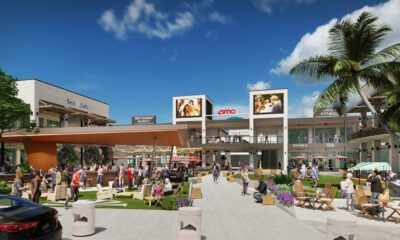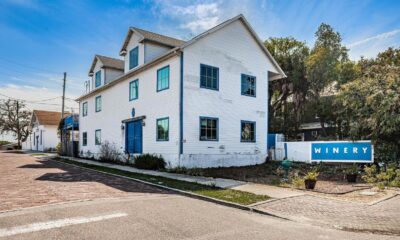Vintage Pinellas: The Gulfport Casino
There’s one question Gulfport Casino manager Justin Shea gets asked more than any other: Where are the slot machines?
The word casino means gathering place, he politely tells guests at the towering, lime green, 88-year-old dance hall at the edge of Boca Ciega Bay. It’s derived from the Italian for little house. “We’ve never had gaming here in the Historic Ballroom, but we are a true casino. An original casino.”
Those famous casinos in places like Las Vegas and Atlantic City, he says, in addition to their gambling facilities, have ballrooms, banquet rooms, meeting rooms … at their core, they’re gathering places. They’re little houses. Over time, the word casino came to implicitly suggest nothing but card games and slots.
Added to the list of National Historic Places in 2014, the Gulfport Casino is almost as old as the city itself. The first iteration was built in 1906, when the salty, sparsely-populated area of southern Pinellas County was known as Veteran City (part of a failed bid to establish it as a retirement community for Civil War vets).
The St. Petersburg & Gulf Railway’s electric trolley line had been extended west from downtown, reaching its terminus at Veteran City. Those who wished to visit distant Pass-a-Grille Beach, or fish in blue Gulf waters, would take the trolley from St. Pete and disembark there, climbing aboard excursion boats that steamed across the bay, back and forth, several times daily.
“People forget that there were no bridges then,” says Cathy Salustri, a historian, author and owner of the Gulfport Gabber newspaper. “There was no Pinellas Bayway, no Corey Causeway. So this was the only way you could get out there.”

Until 1921, when the casino was destroyed by a hurricane, visitors could step off of the electric trolley from downtown St. Pete directly into a steam vessel bound for Pass-a-Grille. Photo: St. Petersburg Museum of History.
Veteran City administrators’ civic improvement plan included a two-story wood frame building, built atop a pier stretching 800 feet into the bay, with a soda fountain, post office, meeting space and dance floor. The second level was open-air, offering nice overwater views and a welcome break from the generally stifling heat.
It soon became a central destination for residents, who held meetings, pot-luck suppers, parties and even church services there. The railway conveniently added tracks right on the pier, allowing the beach-bound to step right from the trolley onto waiting steamboats.
The Town of Gulfport was incorporated – the ceremony took place inside the casino – on Oct. 10, 1910. The first Town Hall was erected in 1913; the railroad proper arrived the following year, opening a vein for the expeditious delivery of construction materials just as the Florida Land Boom was beginning.
The hurricane of October, 1921 reduced the beloved casino to a pile of broken boards, and a replacement was hastily erected, on stick-thin stilts over the water.
According to legend, bandleader Camille Thompson once wondered aloud whether the shaky floor might collapse under the weight of so many square-dancing feet.

The second casino, circa 1922. Gulfport History Museum.
President Franklin Roosevelt’s Works Progress Administration, through the Civil Works Authority, bankrolled an all-new casino building at a cost of $16,000, along with a new fishing pier. Bay bottom was dredged to create the casino site on terra firma, with a protective seawall erected on the waterfront side. Docks were installed to handle the Pass-a-Grille ferry traffic.
Designed by architect Frank Showerman, the 10,000-square-foot wood-and-brick casino opened in December, 1934. It was state-of-the art for its time, with a solid maple dance floor. At the main entrance was a “grand staircase” off Shore Boulevard. Gulf breezes blew in from the large, open window spaces.

Dedication Day, 1935. Photo: Gulfport History Museum.
At the official dedication ceremony in 1935, 1,200 visitors reportedly turned up to hear speeches about Gulfport’s glorious future, and a performance from the Florida Military Academy Band. The military school had recently taken over Gulfport’s bankrupt Rolyat luxury hotel (the school would itself sell to Stetson Law College in 1953).
Artist George Snow Hill, who in the ‘40s created the controversial “racist” mural briefly displayed in St. Petersburg City Hall, painted an historical scene of “Gasparilla and his pirate crew” as the “drop curtain” in front of the band’s performance area.

George Snow Hill’s “drop curtain.” Photo: Gulfport History Museum.
As with St. Petersburg, Gulfport thrived during the winter months, when northerners ventured into Florida to escape the cold. There was a local “society,” or club, for nearly every state, and many of them met, celebrated and otherwise co-mingled at the Gulfport Casino.
Always, there were dances, and social hours, and bingo.
And other activities.
A well-to-do St. Petersburg matron was shot to death at 11 p.m. last night near the Gulfport Casino … held at police headquarters for questioning was Lawrence Minutoli of Tampa, a former Chicagoan … Showing little emotion but waving his hands in typical Italian gestures, Minutoli said “I go to the dances at the Gulfport Casino often and tonight I was surprised to see her there … I asked her to pay me the bill she owes me. She tells me there’s nothing to talk about, so I shot her. She made trouble for me for 10 years. Now she’ll make trouble no more.”
St. Petersburg Times/May 13, 1949

1940s postcard image.
The casino has been renovated and upgraded many times over the years. In 1950, the outer façade was redesigned, and a “bandshell”-type stage was added; the solid maple dance floor was expanded to 100 feet by 56 feet. Next came acoustic tiles – and, in 1958, the city installed air conditioning. Recessed lighting and chandeliers were added in the 1960s.
The “grand staircase” was closed off, and the main entrance moved to the building’s west side in 2003. Extensive shoring-up behind the seawall and concrete support pilings took place, and concrete walkways, with railings, were added.
Manager Shea oversees a staff of three full-time employees and a part-time event staff of 10. The Historic Gulfport Casino Ballroom, as it’s now properly known, is fully owned and operated by the City of Gulfport’s Cultural Facilities Department, and costs approximately $400,000 per year to run.
With very few exceptions – let’s not discuss 2020, the big Covid closure year – the casino has operated in the black for a long time. It pays for itself. There are both weekly and monthly dances, including ballroom, Latin, Argentine tango, swing, contra, disco and rock ‘n’ roll.
Add to that the monies generated by rentals – people or groups who book the venue for their own events – and the intake from the casino’s full bar, and, Shea says, things are going well.
“The city,” he adds, “was incorporated at the first casino, in 1910. And the casino continues to be an economic driver, building the economy by bringing people to the downtown area.”
The Gulfport Casino looms over the waterfront; it’s still the most recognizable – and iconic – building in Gulfport.
“It speaks to a time in our history where we were kind of the end of the line,” observes Salustri. “Where people were just starting to come to Florida … we didn’t really have a culture of tourism yet. It was almost like you were in this frontier, because in the ‘30s Florida was not what it looks like now.
“And then you’re going to go to this nice building with hardwood floors, and you’ll be able to get a snack, maybe a drink, and they’ll have dances or sporting events there, boxing matches, anything like that.
“And you can pretend to be civilized, in the middle of this state that’s actively trying to kill you with mosquitos and hurricanes.”

The solid maple dance floor, 100×56 feet. Photo by Bill DeYoung.








Susan Gore
September 12, 2022at8:03 am
Love seeing the history of Gulfport; thanks for the photos, especially. Justin and the Casino staff are terrific people, as well as consummate professionals.
Deborah Pettingill
September 11, 2022at3:59 am
Held our wedding reception there in 1987 – was a great location!
Laraine O'Neill
September 10, 2022at3:45 pm
I moved here in 1970. One of the first things we did was check out Gulfport. There was a guy at the pier with a Polaroid camera and a paper fish. Took our picture for 50 cents. I still have it.
HAL FREEDMAN
September 10, 2022at3:14 pm
Thanks, Bill. Great article…
Linda Radwan
September 10, 2022at2:33 pm
How much is it to rent the casino
For a wedding in April.